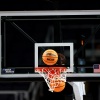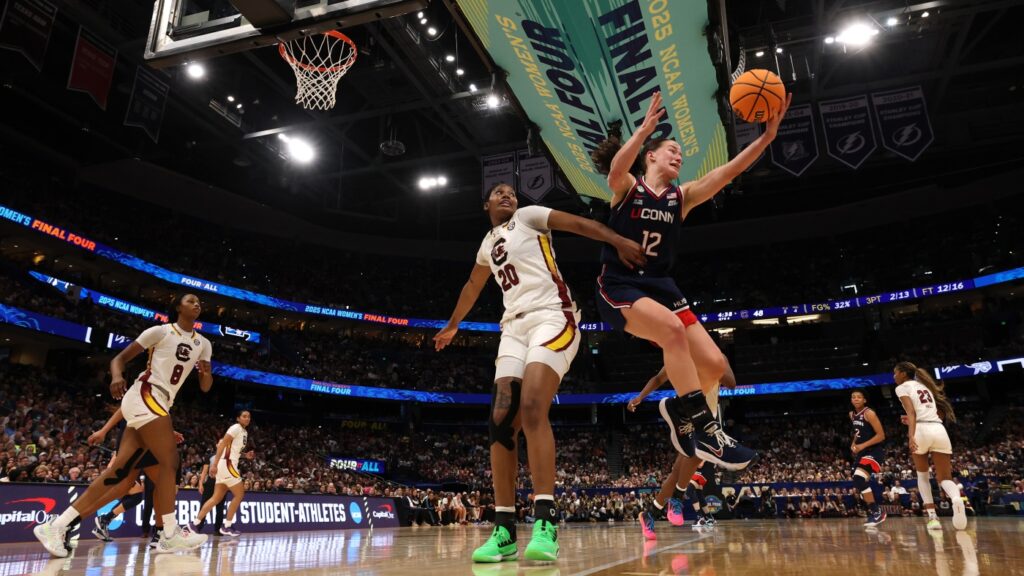
The UConn Huskies defeated the University of South Carolina to win the NCAA Women’s Basketball Championship on Sunday in Tampa. A class-action lawsuit involving thousands of current and former college athletes, known as House vs. NCAA, would transform college sports by allowing schools to pay players directly. A federal judge in California holds the final hearing on the lawsuit beginning Monday.
Maddie Meyer/Getty Images
hide caption
toggle caption
Maddie Meyer/Getty Images
A new era for big-time college sports could be around the corner, as a major legal settlement involving the NCAA and hundreds of thousands of current and former student-athletes appears to be on the brink of approval.

The case, known as House vs. NCAA, or simply the House settlement, offers a sweeping reimagination of how high-level college athletics should work: Schools sharing revenue with student-athletes. Team sizes governed by roster limits, rather than scholarships. A third-party clearinghouse for marketing deals.
“This is a landmark case that’s probably going to be the single biggest structural change in the entire history of collegiate sport,” said Noah Henderson, a one-time Division I golfer at St. Joseph’s University who now directs the sports management program at Loyola University Chicago.
The multibillion-dollar settlement is the proposed solution to three different antitrust lawsuits that were consolidated into one, and it has been in the works for more than a year. On Monday, a federal judge held a final approval hearing to allow supporters and objectors of the settlement to make last arguments about the agreement.
After hours of statements and arguments from lawyers and a handful of current, former and future student-athletes, Judge Claudia Wilken appeared most concerned about objections related to the imposition of roster limits and legal questions about how the settlement would apply to future athletes. Plaintiffs’ lawyers and attorneys for the defendants, the NCAA and its major conferences, both urged the judge to approve the settlement.

“If you look at the history of the litigation in these cases, they have taken years to litigate. The judgments have been small in terms of the injunctions in comparison to what is being put before you today,” said Rakesh Kilaru, a lawyer representing the NCAA. “Here, you have a lot more that’s potentially coming to student-athletes.”
If the settlement is approved, it would pave the way for schools to pay athletes directly — a game-changing reversal of what was once a tradition of amateurism that for a century defined college sports.
In recent decades, though, increasingly lucrative broadcast deals and the commercialization of college sports had led to athletic departments awash with cash. Now, schools in big-time conferences annually earn tens of millions of dollars, if not hundreds of millions, from broadcast deals, ticket sales, merchandise and donations.
As the revenues grew, so too did the pressure to pay players — especially in the income-generating sports of football and basketball. “The money became too big to not allow athletes to get a cut,” Henderson said.

If the legal settlement is approved, as expected, it would pave the way for schools to pay athletes directly — a game-changing reversal of what was once a tradition of amateurism that for a century defined college sports.
Michael Conroy/AP
hide caption
toggle caption
Michael Conroy/AP
Judge Wilken set a deadline next week for lawyers to file a response to the objections raised at Monday’s hearing. The proposed settlement was “worth pursuing,” she said, a suggestion that she would ultimately approve it. But her questions indicated that she may favor some modifications, such as a grandfather clause to ease the impact of the roster limits.
What does the House settlement do?
The settlement has two major parts, one backward-looking and one forward-looking.
First, it offers a remedy for college athletes who played before 2021, the year the NCAA began to allow players to earn money from their name, image and likeness rights, commonly known as NIL. About $2.75 billion is set to be distributed to those players, and the amounts they earn are based on the sport they played and whether they played for a school in a major conference. Football and men’s basketball players from power conferences could earn six figures, while a swimmer or soccer player might earn a few hundred dollars. More than 88,000 former Division I athletes have already made claims as part of the proposed settlement, a plaintiffs’ lawyer said Monday.

The future changes are where the big transformation lies.
Schools in the power conferences (ACC, Big Ten, Big 12, SEC and PAC-12, all of which were named as defendants in the case), along with any other schools that choose to opt in to the settlement, will be able to share revenue with their student-athletes.
In other words, schools will be able to distribute tens of millions of dollars in direct payments to players. The settlement includes a salary cap that will start around $20.5 million, and eventually rise over the years to around $30 million.
The settlement would also impose roster limits, a new concept in college athletics. Traditionally, schools have managed team sizes via scholarship limits — such as 85 for football, 13 for men’s basketball, 14 for women’s swimming and 11.7 for baseball — and those scholarships could be doled out in part or in whole. The proposed settlement would swap those for roster limits — 105 for football, 15 for men’s basketball, 30 for women’s swimming and 34 for baseball. More players could receive scholarships as a result, but some teams may have fewer players, because many schools had previously fielded large teams by offering partial scholarships or allowing walk-ons.
And finally, the settlement creates a third-party clearinghouse for NIL deals worth $600 or more.
How will paying players work?
That’s up to the schools. Programs will have up to the $20.5 million salary cap to work with, but schools may choose not to spend the full amount. It’s likely that most of the money will go to athletes on football or basketball teams, the sports that typically bring in the most revenue.
For most universities, it’s an entirely new way of running an athletics program — a way that looks a lot more like professional sports franchises. Many universities have started to hire general managers who can manage the money side of building a roster: evaluating how much a player is worth in salary, negotiating deals, and so on.

The Tennessee Volunteers celebrate after defeating the Texas A&M Aggies to win the National Championship at the NCAA Division I Baseball Championship on June 24, 2024. One final court hearing is all that stands between big-time college sports and a major legal settlement that is poised to open the door to a new era. On Monday, a federal judge will hold a final approval hearing, during which supporters and objectors to the proposed settlement will speak one last time.
Peter Aiken/Getty Images
hide caption
toggle caption
Peter Aiken/Getty Images
Schools in the five conferences named in the lawsuit — the four “power” conferences, plus the Pac-12 — are automatically part of the settlement. Other schools can choose to opt in.
There’s a risk of a growing financial divide between bigger schools and the smaller programs that decide not to opt in. Eventually, some programs may decide that trying to compete isn’t worth the expense, said Sam Ehrlich, a professor at Boise State University who tracks college sports litigation.
“Even more so than opting in versus opting out, for a lot of those schools, it’s going to be a conversation about is it worth it to be in Division I anymore?” Ehrlich said.
At least one school has already decided to reclassify: Saint Francis, a university in Pittsburgh, announced last month it plans to drop from Division I to Division III in 2026.
“This was not an easy nor a quick decision,” said Joseph Lehman, the chair of the school’s board of regents. Recent changes to college sports, including pay-for-play, he said, had “(moved) athletics away from love of the game.”
What will happen to NIL deals?
Name, image and likeness deals were originally conceived to compensate players for traditional marketing and licensing purposes — like sponsoring by a local car dealership, or earning money from an appearance in a video game.

But over the four years since they were first introduced, many NIL deals had come to essentially operate as compensation for playing for a certain school. Schools would affiliate with an NIL “collectives” and work together to recruit players and offer NIL deals, some of them reaching seven figures.
The settlement aims to give the NCAA and power conferences greater oversight over those deals. Every NIL deal worth $600 or more will have to go through a clearinghouse operated by the consulting firm Deloitte to ensure it’s of fair market value — or, in other words, to make sure an NIL deal isn’t being used to circumvent the school’s $20.5 million salary cap.
This is one of the most contentious parts of the settlement, and it’s almost certain to be challenged in court if the settlement is approved, Ehrlich said.
“There’s going to be significant questions moving forward as to what kind of powers that clearinghouse has and whether the clearinghouse is even legal,” he said.
Who objects to this?
There are a lot of objectors to the settlement. A major portion of Monday’s hearing was devoted to hearing their complaints.

The most compelling objectors appeared to be current or incoming students who’ve been informed that they will no longer have a roster spot after the settlement is approved, due to roster limits shrinking the size of their team. That’s left athletes to face the prospect of paying for tuition that they had expected to receive a scholarship for — or scramble to find a new school for next season. The total number of eliminated roster spots could be in the thousands.
Henderson, the collegiate golfer-turned-Loyola Chicago professor, wrote his own objection letter to the court about the roster limits, urging the settlement to adopt a “practice squad” concept or other solution to allow current players to remain with their teams.
“There’s a large human cost with transferring. Your friends don’t transfer. Your significant other might not want to transfer. Your credits academically might not transfer,” he said. “So these athletes who have spent their entire life working to get to the level of Division I athletics, all of a sudden their opportunities are stripped from them.”

LSU gymnast Livvy Dunne, shown here competing at Auburn University on February 10, 2023, is the highest-earning female athlete in college athletics. She objects to the proposal saying she earned nothing in her freshman year nor while she was in high school due to NCAA rules.
Stew Milne/Getty Images
hide caption
toggle caption
Stew Milne/Getty Images
Judge Wilken listened attentively to the testimony of a high school senior from Pennsylvania, Gracelyn Laudermilch, who had been recruited by several Division I schools for cross country and track.
When Laudermilch called one coach to commit to their school last fall, she said, the coach informed her that the school had just decided to opt into the House settlement, meaning the planned size of the team was in jeopardy. “She didn’t want to cut her girls. She didn’t want to rescind roster spots to recruits,” Laudermilch recalled — but in the end, the coach advised her not to commit. “I hung up the phone, and I cried,” she said.
Wilken suggested several times that roster limits be reexamined for athletes who would be acutely affected by a sudden change — such as a grandfather clause, or a gradual phase-in of the limits.

Other objections included former female athletes or football and basketball walk-ons who said the settlement would not fairly compensate them for their NIL rights. Among objectors who spoke Monday was Livvy Dunne, the LSU gymnast who is the highest-earning female athlete in college athletics.
Since players were first allowed to sign NIL deals in 2021, Dunne, who is now a fifth-year senior, has earned millions of dollars each year from NIL agreements. But she earned nothing her freshman year, nor while she was in high school, she said, due to NCAA rules. “I had a growing platform and millions of followers before I ever stepped foot onto a college campus. Brands were interested. Followers were engaged. Demand was real,” she said. “Had NIL rules not restricted me, my value would have started higher, scaled faster and grown even more.”
What happens next?
Judge Wilken asked lawyers who negotiated the settlement to respond to Monday’s objections by next week. Ultimately, she spoke positively of the settlement as the hearing finished, an indication that she may favor an approval. If that happens, it would set in motion a flurry of activity among colleges and universities as they try to implement the new systems in time for the fall sports season.
No matter what happens with the House settlement, what’s certain to follow are even more lawsuits. There are already more than a dozen lawsuits about various questions that remain open despite this settlement, such as whether the NCAA’s player eligibility rules are legal and whether players should be classified as employees under federal labor law.
And athletic directors from dozens of universities will be on Capitol Hill this week to lobby Congress for legislation codifying the terms of the settlement that could help shield the NCAA and schools from future legal challenges.



